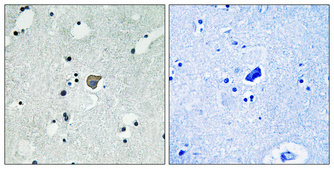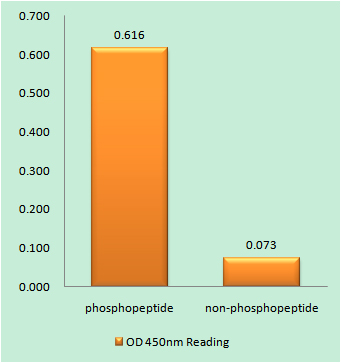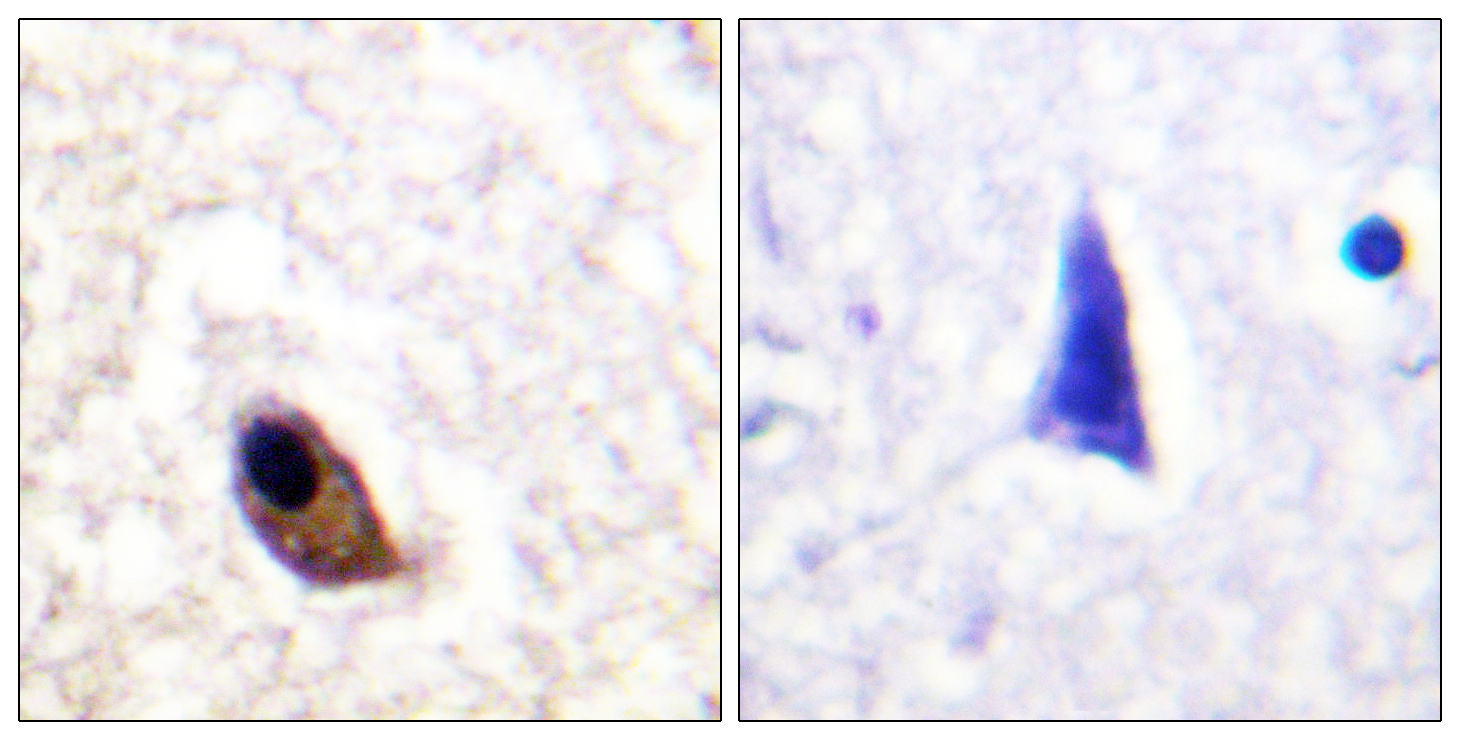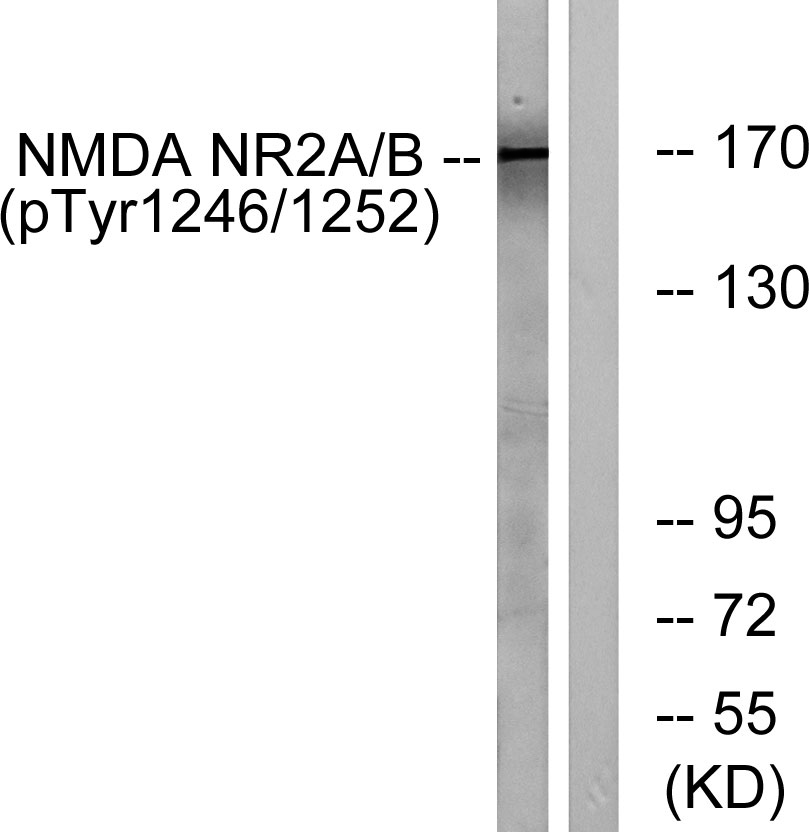NMDAε1/2 (phospho Tyr1246/1252) Polyclonal Antibody
- Catalog No.:YP1147
- Applications:WB;IHC;IF;ELISA
- Reactivity:Human;Mouse;Rat
- Target:
- NMDAε1/2
- Fields:
- >>Ras signaling pathway;>>Rap1 signaling pathway;>>Calcium signaling pathway;>>cAMP signaling pathway;>>Neuroactive ligand-receptor interaction;>>Circadian entrainment;>>Long-term potentiation;>>Glutamatergic synapse;>>Dopaminergic synapse;>>Alzheimer disease;>>Amyotrophic lateral sclerosis;>>Spinocerebellar ataxia;>>Prion disease;>>Pathways of neurodegeneration - multiple diseases;>>Cocaine addiction;>>Amphetamine addiction;>>Nicotine addiction;>>Alcoholism;>>Systemic lupus erythematosus
- Gene Name:
- GRIN2A/GRIN2B
- Protein Name:
- Glutamate [NMDA] receptor subunit epsilon-1/2
- Human Gene Id:
- 2903/2904
- Human Swiss Prot No:
- Q12879/Q13224
- Mouse Gene Id:
- 14811/14812
- Rat Gene Id:
- 24409/24410
- Rat Swiss Prot No:
- Q00959/Q00960
- Immunogen:
- The antiserum was produced against synthesized peptide derived from human NMDAR2A/B around the phosphorylation site of Tyr1246/1252. AA range:1216-1265
- Specificity:
- Phospho-NMDAε1/2 (Y1246/1252) Polyclonal Antibody detects endogenous levels of NMDAε1/2 protein only when phosphorylated at Y1246/1252.
- Formulation:
- Liquid in PBS containing 50% glycerol, 0.5% BSA and 0.02% sodium azide.
- Source:
- Polyclonal, Rabbit,IgG
- Dilution:
- WB 1:500-2000 IHC 1:100 - 1:300. IF 1:200 - 1:1000. ELISA: 1:10000. Not yet tested in other applications.
- Purification:
- The antibody was affinity-purified from rabbit antiserum by affinity-chromatography using epitope-specific immunogen.
- Concentration:
- 1 mg/ml
- Storage Stability:
- -15°C to -25°C/1 year(Do not lower than -25°C)
- Other Name:
- GRIN2A;NMDAR2A;Glutamate [NMDA] receptor subunit epsilon-1;N-methyl D-aspartate receptor subtype 2A;NMDAR2A;NR2A;hNR2A;GRIN2B;NMDAR2B;Glutamate [NMDA] receptor subunit epsilon-2;N-methyl D-aspartate receptor subtype 2B;NMDAR2B;N
- Molecular Weight(Da):
- 170kD
- Background:
- This gene encodes a member of the glutamate-gated ion channel protein family. The encoded protein is an N-methyl-D-aspartate (NMDA) receptor subunit. NMDA receptors are both ligand-gated and voltage-dependent, and are involved in long-term potentiation, an activity-dependent increase in the efficiency of synaptic transmission thought to underlie certain kinds of memory and learning. These receptors are permeable to calcium ions, and activation results in a calcium influx into post-synaptic cells, which results in the activation of several signaling cascades. Disruption of this gene is associated with focal epilepsy and speech disorder with or without mental retardation. Alternative splicing results in multiple transcript variants. [provided by RefSeq, May 2014],
- Function:
- function:NMDA receptor subtype of glutamate-gated ion channels possesses high calcium permeability and voltage-dependent sensitivity to magnesium. Activation requires binding of agonist to both types of subunits.,similarity:Belongs to the glutamate-gated ion channel (TC 1.A.10) family.,subunit:Forms heteromeric channel of a zeta subunit (GRIN1), a epsilon subunit (GRIN2A, GRIN2B, GRIN2C or GRIN2D) and a third subunit (GRIN3A or GRIN3B). Found in a complex with GRIN1 and GRIN3B. Found in a complex with GRIN1, GRIN3A and PPP2CB. Interacts with PDZ domains of AIP1, INADL and DLG4. Interacts with HIP1.,
- Subcellular Location:
- Cell projection, dendritic spine . Cell membrane ; Multi-pass membrane protein . Cell junction, synapse . Cell junction, synapse, postsynaptic cell membrane ; Multi-pass membrane protein . Cytoplasmic vesicle membrane . Expression at the dendrite cell membrane and at synapses is regulated by SORCS2 and the retromer complex. .
- Expression:
- Brain,Cerebellum,Epithelium,Hippocampus,
- June 19-2018
- WESTERN IMMUNOBLOTTING PROTOCOL
- June 19-2018
- IMMUNOHISTOCHEMISTRY-PARAFFIN PROTOCOL
- June 19-2018
- IMMUNOFLUORESCENCE PROTOCOL
- September 08-2020
- FLOW-CYTOMEYRT-PROTOCOL
- May 20-2022
- Cell-Based ELISA│解您多样本WB检测之困扰
- July 13-2018
- CELL-BASED-ELISA-PROTOCOL-FOR-ACETYL-PROTEIN
- July 13-2018
- CELL-BASED-ELISA-PROTOCOL-FOR-PHOSPHO-PROTEIN
- July 13-2018
- Antibody-FAQs
- Products Images

- Immunohistochemical analysis of paraffin-embedded Human brain. Antibody was diluted at 1:100(4° overnight). High-pressure and temperature Tris-EDTA,pH8.0 was used for antigen retrieval. Negetive contrl (right) obtaned from antibody was pre-absorbed by immunogen peptide.

- Enzyme-Linked Immunosorbent Assay (Phospho-ELISA) for Immunogen Phosphopeptide (Phospho-left) and Non-Phosphopeptide (Phospho-right), using NMDAR2A/B (Phospho-Tyr1246/1252) Antibody

- Immunofluorescence analysis of HUVEC cells, using NMDAR2A/B (Phospho-Tyr1246/1252) Antibody. The picture on the right is blocked with the phospho peptide.

- Immunohistochemistry analysis of paraffin-embedded human brain, using NMDAR2A/B (Phospho-Tyr1246/1252) Antibody. The picture on the right is blocked with the phospho peptide.

- Western blot analysis of NMDAR2A/B (Phospho-Tyr1246/1252) Antibody. The lane on the right is blocked with the NMDAR2A/B (Phospho-Tyr1246/1252) peptide.



